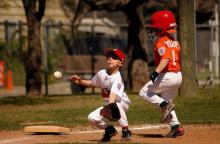
In the acquisition of motor skills, children move through a developmental progression. There are four phases of motor development: the reflexive movement phase, the rudimentary movement phase, the fundamental movement phase, and the specialized movement phase.1
The specialized movement phase typically begins around age 7 when children begin to develop a keen interest in sports. Proper development of fundamental movement skills combined with more precise movement skills are necessary to be able to efficiently develop specialized skills. Mastering the fundamental movement skills leads to easier learning of specific skills.2
During this phase, fundamental stability, locomotor, and manipulative skills are progressively refined and combined for use in increasingly demanding situations. For example, jumping rope involves locomotion (jumping), manipulation (turning the rope), and stability (maintaining balance). Similarly, playing soccer involves locomotor skills (running and jumping), manipulative skills (dribbling, passing, kicking, and heading), and stability skills (dodging, reaching, turning, and twisting).3
There are three stages in the specialized movement phase: the transitional stage, the application stage, and the lifelong utilization stage. Children between the ages of 7 and 10 often possess a strong interest in sports but have little actual ability in the necessary skills to play well. Transitional movement skills contain the same elements of the fundamental movement phase, but with greater form, accuracy, and control. Physical education classes can expose children to the basic skills, rules, and strategies of several sports as well as ensuring that they have mastered the necessary fundamental skills to progress to more refined skills.
The application stage when children are usually between the ages of 11 and 13 finds children begin to make conscious decisions for or against participation in certain activities that require increased skill levels. Choices may include individual sports or team sports, contact sports or noncontact sports, court sports, water sports, or even dance activities. The decisions for or against participation in certain activities are based on how the child perceives his success and enjoyment in the activities will be. Previous successful experiences, body type, geographic location, and emotional, social, and cultural factors all play a part in the decision-making process. The narrowing of interests is accompanied by an increased desire for competence. This desire for competence in form, precision, accuracy, and the skills necessary for good performance are increasingly important to the learner in the application stage.4
The lifelong utilization stage begins around age 14 and continues through adulthood. The level of participation in activities will depend on talent, opportunities, physical condition, and personal motivation. The skills learned in earlier phases are applied to a lifetime of daily living, recreational, and sports-related activities. While some may continue to excel in sports in the collegiate or professional levels, many will choose to develop their movement skills and enjoy recreational sports, whether organized or unorganized, competitive or cooperative.5
- 1. Gallahue, David L. and Frances Cleland Donnelly. Developmental Physical Education for All Children. 4th ed. Champaign, IL: Human Kinetics. 2003. p. 62.
- 2. Ibid. p. 64.
- 3. Gallahue, David L., John C. Ozmun, and Jacqueline D. Goodway. Understanding Motor Development: Infants, Children, Adolescents, Adults. 7th ed. New York, NY: McGraw-Hill. 2012. p. 49.
- 4. Op. cit., Gallahue and Donnelly. pp. 65-66.
- 5. Op. cit., Gallahue, Ozmun, and Goodway. p. 55.

